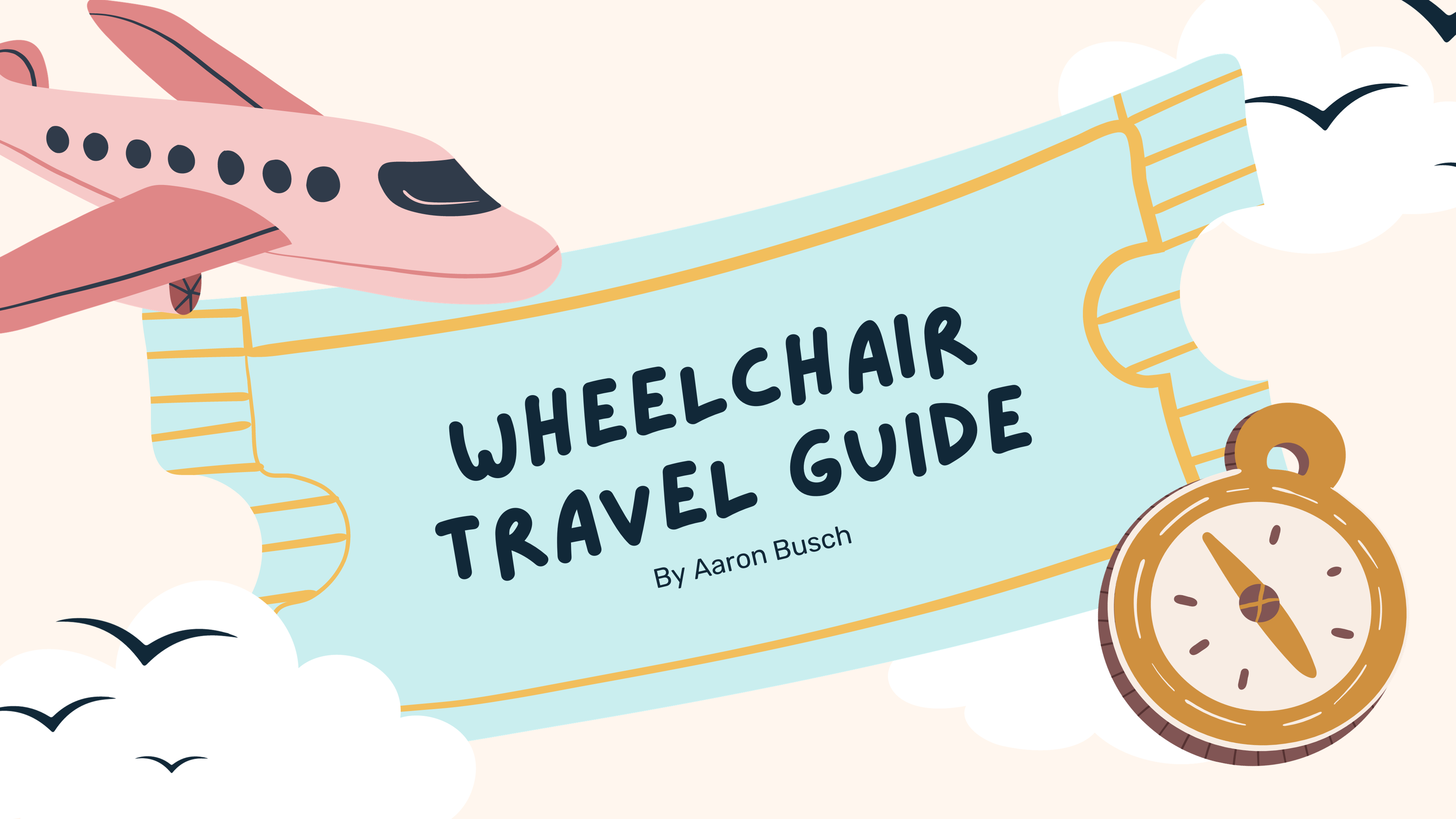Wheelchair Travel Guide: Navigating Airports and Flights for Accessible Travel Journeys
This article was written by OI Community Member Aaron Busch. Aaron brings 20 years of hands-on experience in Accessible Travel to his role as a professional Travel Consultant. He is the founder of Atyzi.com, a platform that equips disabled travelers with resources for secure and inclusive experiences. With a strong track record of booking substantial travel packages, Aaron is dedicated to advocating for the unique needs of his clients. He has also contributed his expertise to notable podcasts like Accessible Media Inc. and Disability After Dark. Aaron specializes in travel solutions that prioritize comfort, accessibility, and enjoyment.
Welcome to this comprehensive Wheelchair Travel Guide, designed to equip you with all the essential information for planning and executing a seamless air travel experience. Specifically tailored for accessible travel, this guide aims to mitigate the risks associated with planning, booking, and embarking on your chosen flights for travelers with mobility challenges.
When taking flights with a wheelchair, understanding your rights under the Americans with Disabilities Act and the Air Carrier Access Act becomes crucial. Equally important are factors like the type of aircraft you will be flying on, as cargo door dimensions can vary significantly. Informing the airline about any specific needs like portable oxygen or pre-clearance for a service animal is also key. Other flight-related considerations include the number of layovers and the time allocated for these connections. Unlike travelers without mobility challenges, you’ll also need to know what professional inspections your wheelchair should undergo before flying and what steps to take if it’s damaged by the airline. This accessible travel guide is designed to bolster your confidence and help you navigate these complexities with ease.
It is not my intent to dictate your travel choices for flights, as you undoubtedly have your own methods and strategies for navigating accessible air travel. Instead, I aim to equip you with comprehensive information that you may review, learn from, and potentially integrate into your existing approach. The objective is to help you identify any overlooked elements that could enhance your accessible travel experience, thereby ensuring a safer and smoother journey to your destination.
Essential Tips for Planning Accessible Flights
It’s essential to understand your rights under two main legislative frameworks: The Americans with Disabilities Act (ADA) and the Air Carrier Access Act (ACAA).
- ADA: Although broad in its scope, the ADA ensures that businesses must provide equal accessibility for individuals with disabilities. While it doesn’t strictly cover airlines, it does cover airport facilities.
- ACAA: The Air Carrier Access Act (ACAA) is a comprehensive U.S. federal law that provides a wide range of protections for passengers with disabilities during air travel. It goes beyond the scope of the ADA by directly regulating the airlines themselves, covering everything from boarding procedures to in-flight accommodations and services. This act ensures that individuals with disabilities have the right to travel with dignity, safety, and equal access.
Wheelchair Dimensions and Aircraft Types
Knowing your wheelchair’s dimensions isn’t just for your own planning—it’s often required by airlines at the time of booking. Measure the height, width, and length of your wheelchair as it will be when transported, which means without any easily removable parts like footrests or the headrest.
Key Point: Airlines typically require these measurements at the time of booking, and you may be asked to provide them in either imperial or metric units depending on your intended route. The Airline should have this information on hand. If you end up booked on a plane that is too small to accommodate your wheelchair in its transportable state, you may face challenges such as being deplaned, rebooked, or receiving your wheelchair damaged at your destination. In addition to dimensions, it’s also crucial to be aware of your wheelchair’s weight. Airlines may have weight limitations for mobility devices, and exceeding these could result in extra fees or the need for special arrangements.
Advance Communication with the Airline
When flying with a wheelchair, it’s crucial to communicate with the airline well in advance for certain accommodations. Here are key items that often require airline pre-clearance:
- Special Equipment: If you intend to bring special medical equipment like a portable oxygen concentrator or a CPAP machine, inform the airline at least 48 to 72 hours before your flight. Airlines may require that your equipment meet specific guidelines or be of approved brands.
- Specific Battery Types: Power Wheelchairs are normally equipped with batteries that are “Gel Sealed” or “Lithium-ion”. You’ll still need to report it to the Airline, but they don’t normally need pre-clearance. “Wet” batteries on the other hand need to be reported and stored in a manner that won’t spill during your flight.
- Service Animals: Domestic flights in the U.S. typically don’t require pre-approval for service animals, thanks to the Air Carrier Access Act. However, the animal must be leashed and well-behaved. For international flights, regulations vary by country and may include vaccination requirements, quarantine periods, or specific certifications. Always check both the destination country’s regulations and the airline’s policy.
- Medical Approval: If you’ve recently undergone surgery, require portable oxygen, or have severe allergies, you’ll generally need medical approval 7-10 days before your flight. This involves submitting a doctor’s note for review, after which the airline may issue a “fit to fly” certificate.
- Companion Discounts: Companions aren’t always a preference, but a medical necessity. Some Airlines offer discounted or complimentary tickets in such a scenario where a supplemental seat needs to be purchased.
Key Point: Don’t leave anything to chance. If you aren’t convinced, reach out to the airline to pre-clear this information at least 72 hours before your flight. This will ensure you do not encounter any interruptions.
Pre-Flight Maintenance: Safeguarding Your Power Wheelchair
The importance of pre-flight wheelchair inspection is often overlooked. Many assume that airlines will readily compensate for any wheelchair damage incurred during travel. While airlines are indeed liable, they may reject your claim by contending that the damage was pre-existing. A professional inspection of your wheelchair before your flight offers documented evidence to refute such claims, should the need arise.
“Bulkhead” Seating and Added Costs
The Bulkhead section is designated for travelers with disabilities. These seats offer enhanced legroom and are located close to the lavatories. Importantly, requesting these seats is not a matter of luxury; it’s your legal right under the Air Carrier Access Act (ACAA). Under this legislation, airlines are also prohibited from levying additional charges for transporting your mobility device and its associated components.
Some Airlines also offer Priority Seating options specifically for travelers with mobility challenges. These seats are usually located near the entrance of the aircraft, making it easier for you to board and disembark. While the specifics can vary from one airline to another, Priority Seating often offers easier access to the aisle and may come with armrests that can be lifted for easier transfers.
Embarking on your Journey
Airport Assistance and Airlines’ Duties
You’ve successfully navigated to the airport—so what comes next? Airports offer a range of amenities, including Curbside Assistance and Short-Term Parking, but the services available can differ. For those landing at major hubs like Hartsfield-Jackson Atlanta International or Denver International Airport, inter-terminal shuttle transportation is often necessary. Therefore, allotting extra time for this part of your journey is a wise move.
In addition to the pre-mentioned inspection, take further preventative measures to safeguard your device. Detach easily removable components and keep them with you in the plane’s cabin. Use zip ties to secure any exposed or loose wires, reducing the risk of damage or hazard. Protect fragile elements like joystick controls with padded covers, especially since cargo can shift during flight. Lastly, if your wheelchair has a freewheel mode, activate it for more straightforward manual handling by Ramp Agents, and provide them with instructions for re-locking the brakes.
Whether you travel with a manual or a power wheelchair, your transfer to an airport-provided wheelchair or aisle chair will be customized to your specific needs. Airports may employ specialized lifting equipment or hands-on assistance, depending on available resources and your unique physical constraints. Once you reach the plane, you have several options. You can walk down the jet bridge (if able), wheel up to an accessible seat to transfer, or using an aisle chair. Should you opt for the aisle chair, airport personnel will assist in physically lifting you into the chair, fastening safety straps to secure you in place. Arriving well ahead of your flight offers the advantage of pre-boarding, allowing you to bypass the stress of boarding amidst the general passenger rush.
The Importance of Communication
Clear communication is crucial when traveling with a wheelchair, yet often you only get one chance to specify handling instructions—at your departure airport. You must request to speak to the Ramp Supervisor before you start the loading process. You have that right. You need to be armed with all the necessary information prior to loading which includes powering on the device, operating sensitive mechanical features such as tilt, recline, and elevate, throttling the speed, disconnecting the joystick cable in an accessible place, engaging and disengaging the brakes, as well as informing the team if your wheelchair has a light package installed. You can’t assume that the Ramp Agents will know these things.
Despite these efforts at the departure point, it’s important to acknowledge the limitations. Due to security and operational policies, you can’t oversee the handling process at your arrival destination or ensure that your instructions are followed.
I developed a free digital tool on Atyzi.com to help bridge these communication barriers. This digital platform allows you to build and store pertinent information for your mobility device and securely share it with a QR Code. You can also print off this QR Code and fixate it to the backrest of your wheelchair labeled “Scan Me”. This information will provide Ramp Agents with immediate access to all the information you have recorded and specified.
Connection Times (Buffer)
Choosing the least expensive flight is not always in your best interest, particularly if you use a wheelchair to travel. A layover shorter than ninety minutes introduces a high risk of missing your connecting flight. The boarding and deplaning processes are more intricate for travelers using wheelchairs, requiring extra time for transferring onto the plane and waiting for personal wheelchairs to be securely stowed. Additional time might also be needed for any unforeseen delays on each leg of your itinerary. Given these considerations, opting for a longer layover minimizes the risk of missing connections and being stranded.
Transportation Security Administration
You can reach out to TSA Cares 72 hours prior to your flight to arrange a more tailored screening process. TSA Officers are also prepared to offer physical assistance such as lifting or holding your device as needed. You may also request additional a private screening area during the pat-down process. Keep in mind, your mobility device will undergo its own inspection and may require the removal the the seat cushion or pads.
Service Animals will undergo a visual inspection and may be subject to a pat-down during the screening process. You may also be asked to remove its harness and leash and guide it through the metal detector.
You may also want to apply for TSA PreCheck, which is a Trusted Traveler Program that can limit the extent of the screening process.
Reporting Damage
It’s crucial to report any wheelchair damage before leaving the airport; otherwise, the airline might evade liability. While airlines often collaborate with reputable firms like Scootaround to handle such incidents, the initial inspection falls on you. Skip mentioning any concerns to flight attendants or ramp agents, as this isn’t their purview. If you discover damage, your first stop should be the Baggage Claims office to initiate the reporting process. In the event your wheelchair becomes inoperable upon landing, first check for simple disconnections—like joystick cables or battery connectors. If neither of these have been tampered with, you can also check the fuse switch before requesting an escort to the Baggage Claims office to inquire about the availability of emergency technical services.
Final Thoughts
If you rely on a mobility device, verify that the aircraft type can accommodate its dimensions. Timing is crucial—opt for layovers longer than 90 minutes to reduce the risk of missed connections or damage to your device. For effective communication, engage with the Ramp Supervisor and consider using digital aids like Atyzi.com for streamlined information sharing.
If your mobility device is returned damaged, report it immediately at the Baggage Claims office. Careful planning and effective communication can significantly reduce the risks, build self-confidence, and enhance your overall experience.








